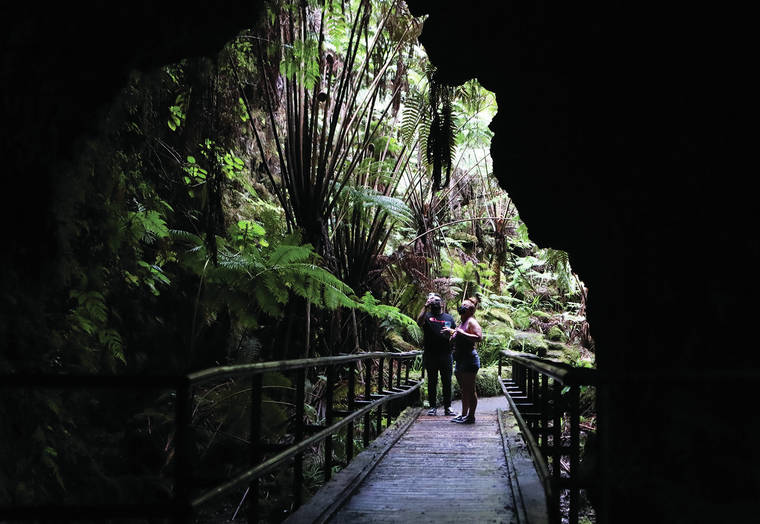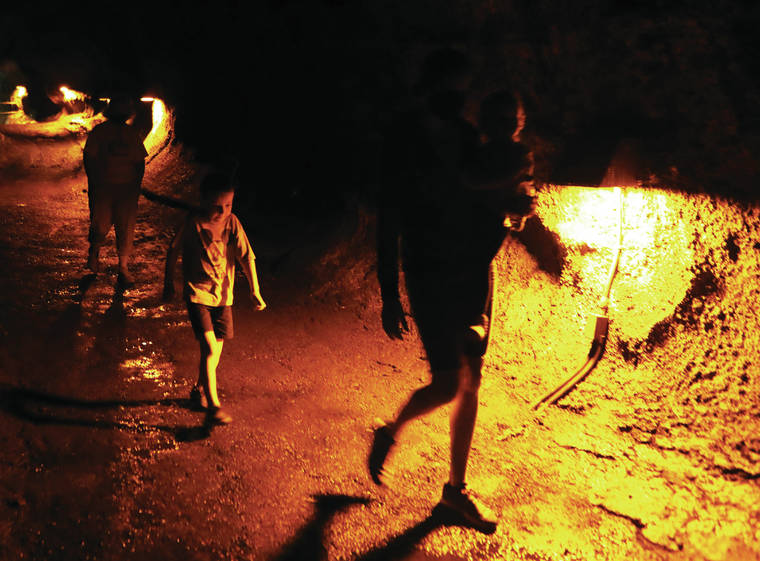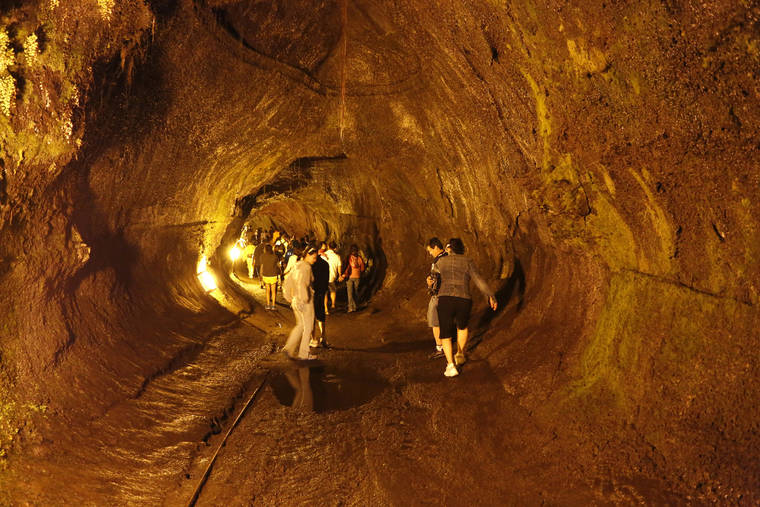Kilauea volcano alternates between periods dominated by lava flows, such as the one we are currently in, and periods of explosive activity. About 1,000 years ago, effusive eruptions broke a 1,200-year period of predominantly explosive activity. During this time, lava flows accumulated on the floor of the Powers caldera — the predecessor of the present-day caldera at Kilauea summit. Eventually, lava filled and started to overflow the caldera, forming two large shields where the caldera had been.
Shortly after the shield formation ended in approximately 1400, lava erupted from a vent on the eastern-most shield, near the eastern end of Kilauea iki crater — commencing the ‘Aila‘au eruption.
The eruption is estimated to have lasted about 60 years during which time about 166 square miles of land was covered by pahoehoe lava flows. For comparison, the 2018 lava flow covered less than one tenth of this area and the longer-lived Pu‘u ‘O‘o flows covered about one third.
The main ‘Aila‘au lava flows advanced to the east and covered most of the Puna District north of the East Rift Zone of Kilauea, leaving numerous kipuka of older lava within the flow field. A large number of communities within the Puna District are built mainly, or entirely, on ‘Aila‘au flows, including, Mauna Loa Estates, Fern Acres, Fern Forest, Hawaiian Acres, Mountain View, Orchidlands Estates, Hawaiian Paradise Park, Ainaloa, and much of Hawaiian Beaches. The Kahauale‘a Natural Area Reserve and the Puna Forest Reserve are also covered in large part by this flow.
The majority of the lava was transported away from the ‘Aila‘au vent by an extensive lava tube network which formed during the eruption. When the eruption ended, much of the lava within the tube drained away, leaving natural subsurface caves. The most well-known tube system, Kazumura cave, is the longest identified continuous lava tube in the world. it starts near Kilauea summit and extends almost to the coast, near Kaloli Point, about 25 miles away. it also has the largest vertical drop of any lava tube, descending approximately 3,600 feet in elevation between the upper and lower extents.
Numerous skylight entrances into Kazumura cave have provided access for scientists, spelunkers, and other curious minds. The complexity of lava tube formation is apparent in the braided tubes, multiple level (stacked) tubes, lava falls, thermal erosion, and many other geologic features preserved within the cave. Lava tubes, including Kazumura, are also home to many Hawaiian cultural sites that are protected by the State of Hawaii. Combining that with the unique biology of lava tubes, these fragile ecosystems and archaeological sites should be respected.
Although Kazumura is the main tube system that transported lava during the eruption, there were many shorter lava tube sections that formed in the ‘Aila‘au flow field. One example, near the ‘Aila‘au vent, is Nahuku (Thurston Lava Tube) on Crater Rim Drive in Hawaii Volcanoes National Park.
in addition to the main flow field to the east of the vent, a small portion of the lava flow was directed south, where it eventually entered the ocean from Keahou Landing to east of Apua point.
The ‘Aila‘au eruption has been studied, mapped, and dated using radiocarbon data, in order to estimate the duration, area, and lava flow volume. The eruption has also been documented in many stories and Hawaiian chants about Pele and Hi‘iaka.
Based on the age ranges of the flows from radiocarbon dating, the formation of Kilauea’s present-day caldera, either abruptly ended, or took place shortly after, the ‘Aila‘au eruption. How the caldera formed in about 1,500 is still poorly understood, having more questions than answers about what triggered the caldera collapse.
Kilauea has a mixed history of explosive and effusive eruptions, with a wide range in duration and size. Because of the profound effect these eruption behaviors can have on our island, the U.S. Geological Survey’s Hawaiian Volcano Observatory continues to study past and present eruptions to better understand Hawaiian volcanoes and their hazards.
Volcano Activity Updates
Kilauea is not erupting. Its USGS Volcano Alert level. Kilauea updates are issued weekly.
No surface activity at Kilauea Volcano has been observed by field crews or webcam images since May 23. For more information on current monitoring of Kilauea, see https://www.usgs.gov/volcanoes/kilauea/monitoring.
Mauna Loa is not erupting and remains at Volcano Alert Level ADVISORY. This alert level does not mean that an eruption is imminent or that progression to an eruption from the current level of unrest is certain. Mauna Loa updates are issued weekly.
This past week, about 58 small-magnitude earthquakes were recorded below the summit and upper elevation flanks of Mauna Loa. GPS measurements show low rates of deformation in the summit region over the past week. For more information on Mauna Loa, see: https://www.usgs.gov/volcanoes/mauna-loa/monitoring.
There was three events with three or more felt reports in the Hawaiian Islands during the past week: a magnitude-4.1 earthquake 5 miles east of Pahala on Aug. 18 at 2:01 a.m.; a magnitude-3.9 earthquake 1 mile southeast of Pahala on Aug. 14 at 1:42 p.m.; and a magnitude-2.8 earthquake 16 miles south of Makena on Aug. 13 at 1:18 p.m.
Visit https://www.usgs.gov/observatories/hawaiian-volcano-observatory for past Volcano Watch articles, Kilauea and Mauna Loa updates, volcano photos, maps, recent earthquake info, and more. Email questions to askHVO@usgs.gov.Volcano Watch is a weekly article and activity update written by USGS Hawaiian Volcano Observatory scientists and affiliates.





